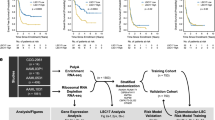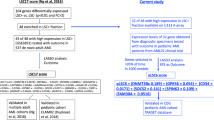Abstract
Despite constant progress in prognostic risk stratification, children with acute myeloid leukemia (AML) still relapse. Treatment failure and subsequent relapse have been attributed to acute myeloid leukemia-initiating cells (LSC), which harbor stem cell properties and are inherently chemoresistant. Although pediatric and adult AML represent two genetically very distinct diseases, we reasoned that common LSC gene expression programs are shared and consequently, the highly prognostic LSC17 signature score recently developed in adults may also be of clinical interest in childhood AML. Here, we demonstrated prognostic relevance of the LSC17 score in pediatric non-core-binding factor AML using Nanostring technology (ELAM02) and RNA-seq data from the NCI (TARGET-AML). AML were stratified by LSC17 quartile groups (lowest 25%, intermediate 50% and highest 25%) and children with low LSC17 score had significantly better event-free survival (EFS: HR = 3.35 (95%CI = 1.64–6.82), P < 0.001) and overall survival (OS: HR = 3.51 (95%CI = 1.38–8.92), P = 0.008) compared with patients with high LSC17 scores. More importantly, the high LSC17 score was an independent negative EFS and OS prognosticator determined by multivariate Cox model analysis (EFS: HR = 3.42 (95% CI = 1.63–7.16), P = 0.001; OS HR = 3.02 (95%CI = 1.16–7.85), P = 0.026). In conclusion, we have demonstrated the broad applicability of the LSC17 score in the clinical management of AML by extending its prognostic relevance to pediatric AML.
This is a preview of subscription content, access via your institution
Access options
Subscribe to this journal
Receive 12 print issues and online access
$259.00 per year
only $21.58 per issue
Buy this article
- Purchase on Springer Link
- Instant access to full article PDF
Prices may be subject to local taxes which are calculated during checkout




Similar content being viewed by others
References
Ward E, DeSantis C, Robbins A, Kohler B, Jemal A. Childhood and adolescent cancer statistics, 2014. CA Cancer J Clin. 2014;64:83–103.
Zwaan CM, Kolb EA, Reinhardt D, Abrahamsson J, Adachi S, Aplenc R, et al. Collaborative efforts driving Progress in pediatric acute myeloid leukemia. J Clin Oncol. 2015;33:2949–62.
Duployez N, Marceau-Renaut A, Boissel N, Petit A, Bucci M, Geffroy S, et al. Comprehensive mutational profiling of core binding factor acute myeloid leukemia. Blood. 2016;127:2451–9.
Hollink IH, Zwaan CM, Zimmermann M, Arentsen-Peters TC, Pieters R, Cloos J, et al. Favorable prognostic impact of NPM1 gene mutations in childhood acute myeloid leukemia, with emphasis on cytogenetically normal AML. Leukemia. 2009;23:262–70.
Creutzig U, van den Heuvel-Eibrink MM, Gibson B, Dworzak MN, Adachi S, de Bont E, et al. Diagnosis and management of acute myeloid leukemia in children and adolescents: recommendations from an international expert panel. Blood. 2012;120:3187–205.
Bolouri H, Farrar JE, Triche T Jr, Ries RE, Lim EL, Alonzo TA, et al. The molecular landscape of pediatric acute myeloid leukemia reveals recurrent structural alterations and age-specific mutational interactions. Nat Med. 2018;24:103–12.
Marceau-Renaut ADN, Ducourneau B, Labopin M, Petit A, Rousseau A, et al. Molecular profiling defines distinct prognostic subgroups in childhood AML: a report from the French ELAM02 Study group. HemaSphere. 2018;2:e31.
Wu X, Feng X, Zhao X, Ma F, Liu N, Guo H, et al. Prognostic significance of FLT3-ITD in pediatric acute myeloid leukemia: a meta-analysis of cohort studies. Mol Cell Biochem. 2016;420:121–8.
Dohner H, Estey E, Grimwade D, Amadori S, Appelbaum FR, Buchner T, et al. Diagnosis and management of AML in adults: 2017 ELN recommendations from an international expert panel. Blood. 2017;129:424–47.
Papaemmanuil E, Gerstung M, Bullinger L, Gaidzik VI, Paschka P, Roberts ND, et al. Genomic classification and prognosis in acute myeloid leukemia. N Engl J Med. 2016;374:2209–21.
Balgobind BV, Raimondi SC, Harbott J, Zimmermann M, Alonzo TA, Auvrignon A, et al. Novel prognostic subgroups in childhood 11q23/MLL-rearranged acute myeloid leukemia: results of an international retrospective study. Blood. 2009;114:2489–96.
Krauter J, Wagner K, Schafer I, Marschalek R, Meyer C, Heil G, et al. Prognostic factors in adult patients up to 60 years old with acute myeloid leukemia and translocations of chromosome band 11q23: individual patient data-based meta-analysis of the German Acute Myeloid Leukemia Intergroup. J Clin Oncol. 2009;27:3000–6.
Kreso A, Dick JE. Evolution of the cancer stem cell model. Cell Stem Cell. 2014;14:275–91.
Bonnet D, Dick JE. Human acute myeloid leukemia is organized as a hierarchy that originates from a primitive hematopoietic cell. Nat Med. 1997;3:730–7.
Greaves M, Maley CC. Clonal evolution in cancer. Nature. 2012;481:306–13.
van Rhenen A, van Dongen GA, Kelder A, Rombouts EJ, Feller N, Moshaver B, et al. The novel AML stem cell associated antigen CLL-1 aids in discrimination between normal and leukemic stem cells. Blood. 2007;110:2659–66.
Witte KE, Ahlers J, Schafer I, Andre M, Kerst G, Scheel-Walter HG, et al. High proportion of leukemic stem cells at diagnosis is correlated with unfavorable prognosis in childhood acute myeloid leukemia. Pediatr Hematol Oncol. 2011;28:91–9.
Hanekamp D, Denys B, Kaspers GJL, Te Marvelde JG, Schuurhuis GJ, De Haas V, et al. Leukaemic stem cell load at diagnosis predicts the development of relapse in young acute myeloid leukaemia patients. Br J Haematol. 2017.
Ng SW, Mitchell A, Kennedy JA, Chen WC, McLeod J, Ibrahimova N, et al. A 17-gene stemness score for rapid determination of risk in acute leukaemia. Nature. 2016;540:433–7.
Castaigne S, Pautas C, Terre C, Raffoux E, Bordessoule D, Bastie JN, et al. Effect of gemtuzumab ozogamicin on survival of adult patients with de-novo acute myeloid leukaemia (ALFA-0701): a randomised, open-label, phase 3 study. Lancet. 2012;379:1508–16.
Law CW, Chen Y, Shi W, Smyth GK. voom: Precision weights unlock linear model analysis tools for RNA-seq read counts. Genome Biol. 2014;15:R29.
Gamis AS, Alonzo TA, Meshinchi S, Sung L, Gerbing RB, Raimondi SC, et al. Gemtuzumab ozogamicin in children and adolescents with de novo acute myeloid leukemia improves event-free survival by reducing relapse risk: results from the randomized phase III Children’s Oncology Group trial AAML0531. J Clin Oncol. 2014;32:3021–32.
Lange BJ, Smith FO, Feusner J, Barnard DR, Dinndorf P, Feig S, et al. Outcomes in CCG-2961, a children’s oncology group phase 3 trial for untreated pediatric acute myeloid leukemia: a report from the children’s oncology group. Blood. 2008;111:1044–53.
Cooper TM, Franklin J, Gerbing RB, Alonzo TA, Hurwitz C, Raimondi SC, et al. AAML03P1, a pilot study of the safety of gemtuzumab ozogamicin in combination with chemotherapy for newly diagnosed childhood acute myeloid leukemia: a report from the Children’s Oncology Group. Cancer. 2012;118:761–9.
Harrison CJ, Hills RK, Moorman AV, Grimwade DJ, Hann I, Webb DK, et al. Cytogenetics of childhood acute myeloid leukemia: United Kingdom Medical Research Council Treatment trials AML 10 and 12. J Clin Oncol. 2010;28:2674–81.
Ellegast JM, Rauch PJ, Kovtonyuk LV, Muller R, Wagner U, Saito Y, et al. inv(16) and NPM1mut AMLs engraft human cytokine knock-in mice. Blood. 2016;128:2130–4.
Gentles AJ, Plevritis SK, Majeti R, Alizadeh AA. Association of a leukemic stem cell gene expression signature with clinical outcomes in acute myeloid leukemia. JAMA. 2010;304:2706–15.
Schuurhuis GJ, Heuser M, Freeman S, Bene MC, Buccisano F, Cloos J, et al. Minimal/measurable residual disease in AML: a consensus document from the European LeukemiaNet MRD Working Party. Blood. 2018;131:1275–91.
Acknowledgements
We thank all the patients, their families, and the staff of all the centers of Société Française des Cancers de l’Enfant (SFCE) for their implication in the trial. The results published here are in part based upon data generated by the TARGET initiative managed by the NCI. The AML Project data used for this analysis are available at https://ocg.cancer.gov/programs/target/data-matrix. More Information about TARGET can be found at http://ocg.cancer.gov/programs/target.
Funding
This work was supported by the French National Cancer Institute (INCA-DGOS_5797) and by a grant from the French Ministry of Health (PHRC-K 2003 no 03142). The Trousseau laboratory received funding from the Association Laurette Fugain and La Fondation de France to support molecular study and the ELAM02 national tumor Bank. Integrated research program: pediatric cancer PAIR grant: CONECT-AML INCA PRT-K: CAMELIA.
Author information
Authors and Affiliations
Contributions
GL was the principal investigator of the ELAM02 trial. AP, FG, BN, GM, AB, YB, GL enrolled patients in the study. AR ensured database management. ND, AMR, CP, and HL performed genetic analysis. SN, JW, and JD provided materials and protocols. ND, CV, FL, MF, MC performed Nanostring assay and analyzed data. AP and MC performed statistical analysis. ND, AB, NP, CP, and MC wrote the manuscript which was approved by all the authors.
Corresponding authors
Ethics declarations
Conflict of interest
The authors declare that they have no conflict of interest.
Electronic supplementary material
Rights and permissions
About this article
Cite this article
Duployez, N., Marceau-Renaut, A., Villenet, C. et al. The stem cell-associated gene expression signature allows risk stratification in pediatric acute myeloid leukemia. Leukemia 33, 348–357 (2019). https://doi.org/10.1038/s41375-018-0227-5
Received:
Revised:
Accepted:
Published:
Issue Date:
DOI: https://doi.org/10.1038/s41375-018-0227-5
This article is cited by
-
Verification of prognostic expression biomarkers is improved by examining enriched leukemic blasts rather than mononuclear cells from acute myeloid leukemia patients
Biomarker Research (2023)
-
Regulatory T cells promote the stemness of leukemia stem cells through IL10 cytokine-related signaling pathway
Leukemia (2022)
-
Relapsed acute myeloid leukemia in children and adolescents: current treatment options and future strategies
Leukemia (2022)
-
A primary hierarchically organized patient-derived model enables in depth interrogation of stemness driven by the coding and non-coding genome
Leukemia (2022)
-
Leukemic stem cell signatures in Acute myeloid leukemia- targeting the Guardians with novel approaches
Stem Cell Reviews and Reports (2022)



